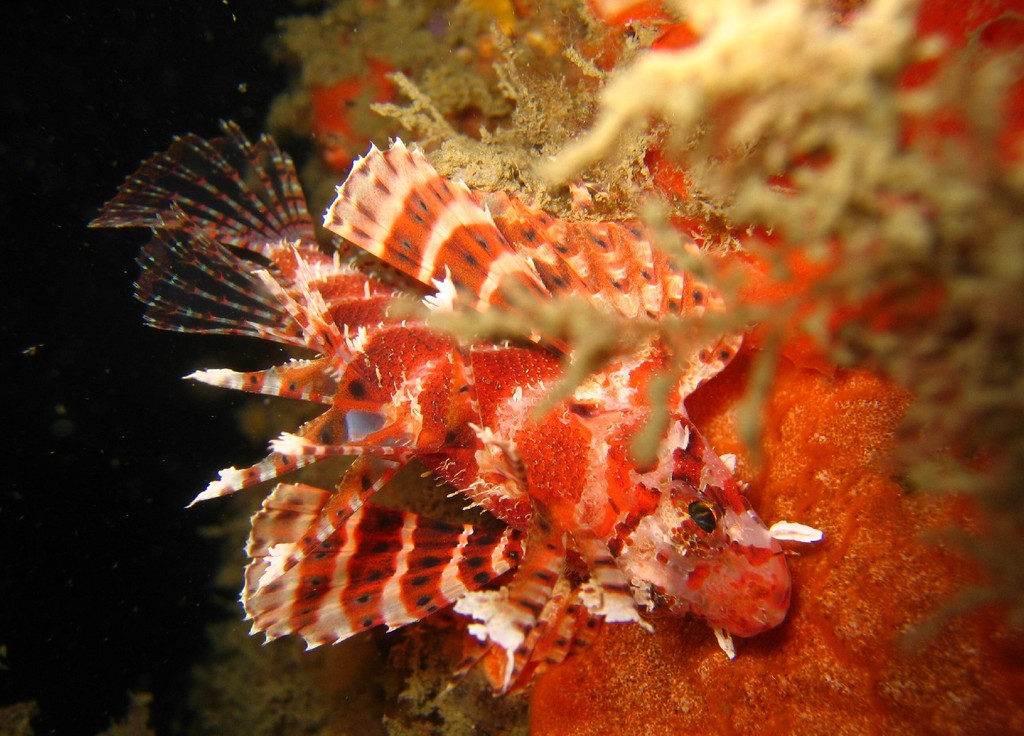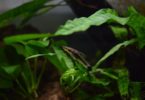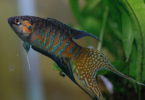Last Updated on November 19, 2022 by Matt
The Dwarf Lionfish, Dendrochirus brachypterus, is also called the shortfin turkeyfish and the fuzzy dwarf lionfish. This fish is a member of the Dendrochirus genus, which is a genera of fish within the Scorpion Fish family, Scorpaenidae, along with the leaf scorpionfish and ambon scorpionfish. All of the lionfish in this genus are collectively known as the dwarf lionfish, as they are all fairly small animals, although Dendrochirus brachypterus is most commonly called simply the dwarf lionfish.
In this dwarf lionfish care guide, we will run through how to keep these fish successfully in the home aquarium.
IN THIS ARTICLE
Fuzzy Dwarf Lionfish Care Guide
| Dwarf Lionfish Summary | |
| Care Level | Moderate |
| Family | Scorpaenidae |
| Temperament | Semi-aggressive |
| Diet | Carnivore |
| Origin | Indo-Pacific |
| Minimum Tank Size | 50 Gallons |
| Color | Red, white, black |
| Size | Up to 7 inches |
| Reef Compatible? | With caution |
| Temperature | 73-84℉ (22.8-28.9℃) |
| Salinity | 1.020-1.025 |
| Carbonate Hardness | 8-12 dKH |
| pH Range | 8.1-8.4 |
Description
The fuzzy dwarf lionfish, scientifically known as Dendrochirus brachypterus, is a marine fish found in waters of the Indo-Pacific. This fish is a favorite to many experienced aquarists due to its eye catching appearance and slow, graceful movements in the aquarium. The dwarf lionfish has a small body made up of red, white and black vertical stripes, with delicate fan-like pectoral fins and tall dorsal fins. In the wild they can grow up to around 5-7 inches, however in captivity then are seen to be slightly smaller, usually around 5 inches at the maximum.
They are also known as the fuzzy dwarf lionfish, named after their cute appearance, however this fish can show its aggressive side when other fish get in its way.
Dwarf lionfish are great hunters and generally eat any small animal that is nearby, they are also not afraid to consume larger prey such as fish or large invertebrates.
As beautiful and elegant this fish appears to be, they need to be cared for with caution, as they are protected by venomous spines. Dwarf lionfish are not aggressive all the time, and they will generally stay out of the way if you were to put your hand in their tank, however they will not be scared to sting you if they feel stressed or threatened; so it is important not to move your hand around their environment. Their venom gland is linked to all 13 of their dorsal fin rays, making them capable of giving you a very painful sting despite their small and endearing appearance. It has been found that their sting can be treated at home using hot water of 113°F (45°C) to destroy the venom, however this is not always effective and it is recommended to seek medical treatment after a sting.
Distribution
The dwarf lionfish is an exclusively marine species native to the Indo-West Pacific region where it inhabits shallow coastal areas often hiding in caves and waiting to ambush its prey. They are often seen throughout the Indian Ocean, from the East coast of Africa, throughout the Indian coastline, and Australia, and extend into the Western Pacific Ocean from the east Australian coastline to Tonga and their range extends northward to Japan.
They have now spread into non native areas such as the Caribbean where they are seen as an invasive species.
Dwarf lionfish favorite rocky areas that are full of invertebrates, fish and crustaceans.
Aquarium set up
In our opinion, the minimum tank size for one dwarf lionfish is 50 gallons, as they are pretty small fish and they also are not big swimmers; they spend most of their day slowly moving around the tank or hiding amongst the rock. 50 gallons is the minimum tank size that is recommended, however we always recommend to go bigger rather than smaller, as long as you pack the tank with hiding spots to prevent them from feeling exposed. If you are housing a dwarf lionfish with other fish, you will need to consider the other species requirements and house them in a much larger aquarium.
Dwarf lionfish are reef compatible, however you do have to be cautious and keep an eye on the fish due to their eating habits. The main caution with housing this fish in a reef aquarium is the other species inhabiting the tank. Most reef aquariums are communities composed of both small and large fish, and invertebrates such as shrimp, mollusks, and echinoderms.
Small to medium fish and invertebrates cannot be kept in the same aquarium as the dwarf lionfish, they will be seen as food. So keeping this fish in a reef aquarium does limit you regarding what species you can have in the tank.
One of the most important requirements of setting up a tank for the dwarf lionfish is making sure that they have enough hiding spots. This can be from coral or a rocky set up, or even macroalgae such as seaweed. Especially when newly introduced into a new tank, fuzzy dwarf lionfish will seek shelter, and need numerous places to hide or they will be greatly stressed.
Fuzzy dwarf lionfish need a temperature range of 73-84℉, a specific gravity of 1.020-1.025, a carbonate hardness of 8-12 dKH, and a pH range of 8.1-8.4.
Behavior and diet
When first introducing a dwarf lionfish to its new aquarium, they become quite shy; so it is important to leave them to acclimatize to their surroundings and settle in before disturbing them with cleaning or too much movement around the tank. Even feeding can wait until they are confident, as they may not be interested in the food and it will cause the food to rot and contaminate the water.
Dwarf lionfish are charismatic fish that can often be found carrying out unusual behaviors both in the wild and in captivity. They are sometimes seen lying upside down in caves or next to ledges, it is important to create areas in an aquarium where they can do this.
These fish will not go out of their way to attack or bother other fish, provided they are given enough space and hiding spots to feel comfortable. Situations like an overcrowded tank, constant cleaning and interfering, or being housed with aggressive tank mates are examples of when this fish will become stressed and aggressive, this will end up in other fish or yourself getting stung.
Regarding food, dwarf lionfish are carnivores that eat fish, invertebrates and crustaceans in the wild. In captivity, it is important to replicate this diet as much as you can, using live and frozen foods; however lionfish do tend to prefer live food over dead food.
Live food such as feeder fish (guppies, mollies), shrimp and crabs can be given to the lionfish. Shrimp are a good option when first feeding this fish in a new environment, you can then move onto other live food when they are settled in.
These fish can be fed with frozen food, however it will be a difficult process. They are more likely to eat a live animal that is physically darting across the water than something that does not move, however the switch can be done if you are patient. The best way to feed frozen food to a dwarf lionfish is by using long tongs (do not feed this fish with your hands). Throwing the food into the tank will just sink to the bottom and most likely rot away, sometimes the fish will see the sinking food and eat it, but it is unlikely.
When using tongs, hold the food at face level with the fish, but not too close. It is best to move the tongs back and forth to try and mimic movement that their prey would do, this will hopefully trigger the fish’s hunting instincts.
Even though they can be fed with frozen food, we do recommend feeding them live food, it stimulates their hunting instincts and replaces the behaviors that they would carry out in the wild; it creates a much more natural environment. It is also great to watch.
Dwarf lionfish are good eaters and will consume everything you offer them, so they will not say no to overfeeding. It is easy to overfeed these fish as they always appear hungry, however they will not eat everyday in the wild so it is important to replicate this as much as you can in an aquarium. They can be fed in small portions every other day, they should also get a mix of food and not the same food every time.
Dwarf Lionfish Tank Mates

Tank mates for the dwarf lionfish have to be chosen very carefully, as this fish will eat anything that will fit in its mouth, and it can open its mouth very wide, so even bigger fish can be at risk.
These fish are solitary animals, and they will be more than happy in an aquarium by themselves, so tank mates are not a must. However, keeping several fish species in one aquarium is always easier than having several separate tanks, as it creates an easier cleaning routine.
Tank mates should not be too aggressive, especially if they are known to constantly nip and annoy other fish; this includes puffer fish and triggerfish. However, the dwarf lionfish can be housed with semi-aggressive or even slightly more aggressive fish.
This is because peaceful and docile fish may become stressed in the company of the lionfish, as they can be confident and aggressive. Most aggressive fish will also be able to defend themselves against the dwarf lionfish, whereas other species will not be able to.
Small fish will be eaten in no time, and even medium sized fish such as damsels, blennies and gobies can even be a tasty meal for the lionfish. After choosing a selection of compatible tank mates regarding behavior and personality, you then need to ensure that the species all have similar parameter requirements, including temperature and pH. You cannot house two species that have different requirements.
Conclusion
To sum up, the dwarf lionfish is an incredible species to keep in your home, with their beautiful fins, eye catching stripes and slow graceful movement they really do make a statement. Their dangerous spines also create a sense of achievement in having this species in your aquarium.
Provided that you care for them with caution and give them the correct environment, this fish will be a great addition to any fish enthusiasts collection.
Dwarf lion fish can be housed alone or with other predatory fish that are large enough to avoid being swallowed, other venomous species can be good house mates for these fish.
These fish are pretty hardy fish and will do well with beginners, but ensure you are confident in housing this species and ensure you take precautions when going near this fish.
Featured Image Credit: Richard Ling – Flickr, CC BY-SA 2.0, https://commons.wikimedia.org/w/index.php?curid=1885823







